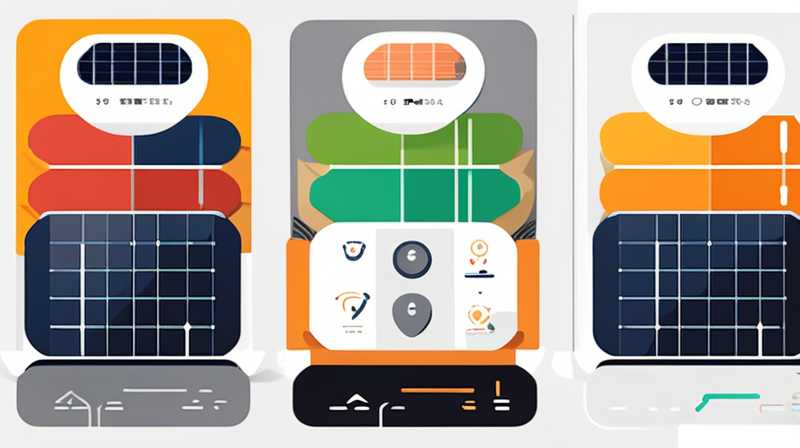
1. SOLAR RACK TYPES COMPARISON
When addressing the inquiry regarding the superior solar rack, it is essential to evaluate various factors influencing their effectiveness. 1, materials, cost, durability, ease of installation. Different types of solar racking systems are available in the market, each offering unique advantages for specific applications. 2, ground-mounted racks, roof-mounted systems. The environment and the installation’s context will play critical roles in determining the most suitable option for a given scenario. Among the commonly discussed types, ground-mounted racks are preferred for larger arrays due to their higher durability and ease of access for maintenance.
2. NAVIGATING SOLAR RACKING SYSTEMS
Solar racking systems are critical components in solar energy management, significantly influencing efficiency and long-term performance. Numerous racking systems exist, each tailored for various installation types and preferences. To navigate this landscape effectively, it becomes imperative to categorize the systems into distinct types, drawing clear distinctions based on focus areas such as installation method, material, and purpose.
GROUND-MOUNTED RACKS
Ground-mounted racks provide substantial benefits, especially for larger installations. Primarily designed for open areas where roof space may be limited, these systems allow for enhanced energy absorption by adjusting the angles to optimize sunlight exposure. Furthermore, the structural integrity of ground-mounted systems is generally robust, made from materials designed to withstand environmental stresses such as strong winds and heavy snowfall.
Additionally, maintenance aspects play a significant role in choosing ground-mounted racks. These systems are designed to be easily accessible, facilitating regular inspections and repairs. While initial costs may be high due to extensive groundwork preparation, the long-term benefits often justify the investment. Thus, ground-mounted racks are an excellent investment for commercial setups or large-scale residential projects where space and efficiency are pivotal.
ROOF-MOUNTED RACKS
Roof-mounted solar racks are another common choice, particularly for residential applications. This type of mounting takes advantage of existing structures, thereby avoiding additional land costs. The primary advantage here lies in space efficiency; utilizing roof areas helps in conserving premium land space while making energy collection available right at homes and buildings.
However, installation complexity is an important consideration. Roof-mounted systems may require specialized labor and equipment to ensure safety and structural integrity during installation. The long-term implications of roof-mounted installations can vary significantly due to factors like roof age, type, and pitch. Additionally, these systems can be more challenging to maintain compared to ground-mounted arrays.
3. MATERIALS IN SOLAR RACKING
The materials used in solar rack construction significantly influence performance, durability, and overall lifecycle. Common materials include aluminum, stainless steel, and metal alloys, each offering varied benefits and drawbacks.
ALUMINUM SYSTEMS
Aluminum is a favored option due to its lightweight qualities and resistance to corrosion. This material allows for lower installation costs, primarily due to reduced labor intensity during setup. Additionally, aluminum racks require minimal maintenance, resulting in cost savings over the systems’ entire lifespan.
However, one must consider the material’s strength. While aluminum provides sufficient support for standard installations, areas subjected to extreme weather conditions may necessitate further reinforcement or the use of heavier materials. Ultimately, the choice of aluminum hinges on the local climate and long-term sustainability goals of the project.
MATERIALS WITH STAINLESS STEEL
Conversely, stainless steel racks offer remarkable durability and resistance to harsh weather. This material is particularly suitable for regions prone to severe weather conditions, including hurricanes or heavy snowfall. The longevity of stainless steel systems is commendable, as they can endure adverse conditions with little to no degradation.
Nonetheless, the downside of stainless steel is the increased upfront costs associated with materials and installation. While providing superior strength, the heavier weight may lead to higher labor costs during installation. Decision-makers must assess whether the benefits of stainless steel justify the higher investment in light of their specific solar energy needs.
4. COST ANALYSIS
Cost remains one of the critical factors in deciding the best solar rack. Analyzing initial installation costs, long-term durability, and efficiency is crucial for an informed decision.
INITIAL EXPENSES
When evaluating costs, initial expenses should encompass materials, labor, and any site preparation. Ground-mounted systems typically incur higher upfront costs due to excavation, concrete foundations, and more significant equipment requirements. In contrast, roof-mounted systems can minimize these initial costs by using existing structures. However, any installation must be assessed based on the specific site’s conditions.
LONG-TERM VALUE
Over time, maintenance costs and efficiency ratings will also influence long-term expenses. If a system withstands environmental challenges and requires fewer repairs, it can provide a better return on investment despite a higher initial outlay. Therefore, decision-makers must consider not only the upfront financial commitment but also the projected lifespan and reliability of different racking types.
5. INSTALLATION EASE AND MAINTENANCE
The ease of installation and ongoing maintenance can also play significant roles in determining the best solar rack option.
INSTALLATION COMPLEXITY
For ground-mounted systems, professional labor is usually required, involving heavy machinery for excavation and assembly. For those considering roof-mounted solutions, the pitch and materials of the existing roof significantly influence installation complexity. A flat roof, for instance, can simplify the installation process, while a steep or irregularly shaped roof might necessitate tailored solutions.
MAINTENANCE REQUIREMENTS
In terms of maintenance, ground-mounted racks are often easier to maintain due to their accessibility. Roof-mounted systems may require periodic inspections by trained professionals, especially after extreme weather events. Properly maintaining solar racks ensures they operate at peak efficiency, ultimately translating to improved energy production over the systems’ lifespan.
6. CLIMATE CONSIDERATIONS
Local climate plays a crucial role in determining the most appropriate solar rack type. The durability of materials, structural design, and installation preferences can hinge significantly on weather conditions and historical climate patterns.
EXTREME WEATHER IMPACTS
Regions prone to heavy snowfall or hurricanes may necessitate heavy-duty racks capable of withstanding substantial weight or wind forces. For example, systems must be designed to endure snow loads in cold climates, potentially leading to higher material and engineering costs. Conversely, areas with less extreme weather conditions may not require such robust designs.
EFFECTS OF SUNLIGHT AND TEMPERATURE
Moreover, direct sunlight exposure and extreme temperatures can influence material selection. While aluminum may remain unaffected by thermal expansion, stainless steel could present complications if it expands and contracts more than anticipated. Being cognizant of these factors aids in making informed choices regarding material and installation.
7. LONGEVITY AND WARRANTIES
A deep exploration into the lifespan and warranty associated with solar racks can serve as a vital determinant in decision-making.
LIFESPAN OF RACKS
Typically, solar racks can last anywhere from 25 years to several decades if maintained properly. Evaluating the average lifespan of various materials is crucial; for instance, aluminum systems can be expected to last similarly, if not longer than their stainless steel counterparts in less extreme environments.
WARRANTY TERMS
In addition to material longevity, warranty coverage can offer vital insights into manufacturer confidence in their products. Comprehensive warranties signify strong backing and reassurance regarding durability over time. Decision-makers should compare warranty terms, including coverage for materials and potential structural failures, to safeguard their investments against unforeseen challenges.
8. FUTURE TECHNOLOGICAL ADVANCEMENTS
Emerging technologies continuously reshape the future landscape of solar energy, including solar rack designs.
INNOVATIVE MATERIALS AND DESIGNS
As the industry evolves, manufacturers are exploring lighter, more robust materials to enhance efficiency and sustainability. These innovations may lead to lighter systems that still provide comparable durability and strength. Furthermore, modular designs are gaining popularity, allowing users to scale their operations without extensive modification to existing infrastructure.
ANALYZING ADVANTAGES OF FUTURE SOLUTIONS
Future solutions may also integrate technology for real-time monitoring of energy production and faults in the rack systems. Anticipating these advancements when choosing a solar rack enables decision-makers to explore long-term strategic planning with adaptability in mind, leading to more sustainable energy solutions.
FREQUENTLY ASKED QUESTIONS
1. WHAT ARE THE PRIMARY DIFFERENCES BETWEEN GROUND-MOUNTED AND ROOF-MOUNTED SOLAR RACKS?
The primary distinctions between ground-mounted and roof-mounted solar racks revolve around installation practicality and site requirements. Ground-mounted systems are typically suited for larger installations on open properties, providing flexibility in orientation and angle adjustments for optimal sunlight exposure. Roof-mounted systems capitalize on existing structures and are ideal for smaller residential setups but may face limitations due to roof pitch and type. Additionally, ground-mounted systems often facilitate easier access for maintenance, while roof-mounted arrays pose accessibility challenges that may require professional service.
2. HOW DO CLIMATE CONDITIONS AFFECT SOLAR RACK INSTALLATION?
Climate significantly impacts solar rack installation decisions, influencing material selection, structural design, and maintenance requirements. For areas with extreme weather, such as hurricanes or heavy snowfall, selecting durable and robust materials becomes essential. Ground-mounted racks may require deeper and more substantial foundations to withstand these forces, whereas roof-mounted racks must be securely anchored to prevent lift-off during wind events. Understanding local climate patterns ensures that systems perform reliably, avoiding failures during adverse conditions.
3. WHAT ROLE DO WARRANTIES PLAY IN THE DECISION-MAKING PROCESS?
Warranties play a critical role in solar rack decision-making by offering protection against material defects and structural failures. A comprehensive warranty signifies a manufacturer’s confidence in the product’s longevity and durability, providing peace of mind for end-users. When evaluating options, potential buyers should scrutinize warranty terms, covering aspects such as material degradation, environmental impacts, and overall lifespan. Optimal warranty coverage serves as an indicator of quality assurance, guiding decisions towards more reliable installations.
IN SUMMARY,
Choosing the best solar rack entails a multifaceted evaluation of several critical factors, including material types, installation costs, environmental conditions, and the longevity of systems. Different mount types offer unique advantages suited for varying circumstances, with ground-mounted options typically excelling in durability and ease of access. As advancements in technology emerge, incorporating innovative materials and designs may further enhance the efficiency and functionality of solar racking systems. Ultimately, informed decision-making based on comprehensive knowledge of these considerations will lead to optimal investments, ensuring that solar energy systems provide sustainable and efficient energy collection over their operational lifespan. Making an informed choice amidst varying options guarantees not only immediate benefits but also long-term sustainability in solar energy endeavors.
Original article by NenPower, If reposted, please credit the source: https://nenpower.com/blog/which-solar-rack-is-better/


